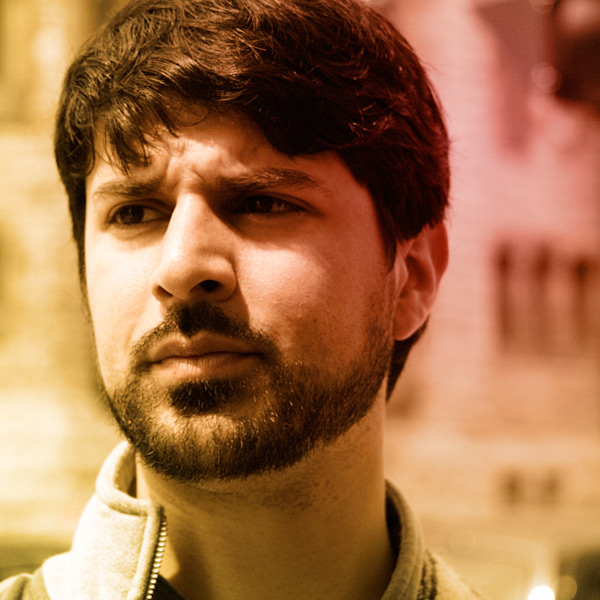
Ensemble Allogène is a new, intense contemporary music group from Montreal. Isak Goldschneider of Innovations en concert met with their pianist, Daniel Áñez, for a conversation in a practice room at McGill University.
Could you say something about your influences, and about the sound that you’re trying to develop as an artist?
The Latin American music that’s influenced me the most is music that’s very direct. It’s very unsophisticated, in a beautiful way. There are some pieces that have just one note, for example, a different style of minimalism, because it’s so austere. It’s like “poor music”- the Italians had arte povera, and in the same way we have something that’s very poor and ideologically aware. So what I try to do with my music and programming is to make people understand that there’s something unrooted about music in society. Although that it might seem that contemporary music is this elitist endeavour, I think we can take it beyond this, creating a real communication which discusses the social problems we face- but from a musical perspective, free from dogma and propaganda. Music has an important role in today’s society.
You’re performing Piano Mechanics Gordon Monahan for Innovations en concert this September. What attracted you to this work in the first place?
I heard about Gordon Monahan for the first time in Uruguay last year. It was really weird- I was looking for repertoire and I asked my friend and teacher, the composer Graciela Paraskevaidis, if there was anything she could recommend. Amongst the list of pieces she sent me was this work by Gordon Monahan, and I was totally intrigued: who was Gordon Monahan? I went to his website and saw that he was into sound installations and sound art and performance art. I loved it, and after keeping a score from his website on my desk for a long time, [Innovations en concert director] Cassandra Miller asked me to play some Canadian repertoire. I thought it was the best opportunity to play this piece.
I find Monahan’s work very interesting in that it exists in a space that’s influenced by sound art and installations. Do you think there’s a relationship between this piece and the media I mentioned?
No, I don’t see it as an installation. I’d describe it as nine etudes, where he tries to extract diverse, brutal sounds from the piano as a machine. As an object which exists without instructions. So he approaches the keyboard, the piano in very different ways: through repeated notes, through damping, etc. But what does resemble an installation in this piece is the way in which things happen in the long term. For example, there’s a note that’s repeated for a very long time- say, two minutes. And the magic of this note starts to appear as the auditorium is filled with its resonance. In a way, the sound becomes an object here. Music in this work is not a discourse or narrative moving here or there- no, the objects he works with are almost physical. They are things that resonate in space and that can be observed from different angles. There is no development in that sense.
A certain rawness to the work?
Absolutely, it’s brutal. And very simple- you can probably sight-read the score.
I wonder if you could tell be something about Ensemble Allogène, the group that you’re playing with at Innovations en concert.
I’d say that the group’s work is very original but very sincere at the same time, based on pure experimentation rather than how to make radical music appealing. There are no commercial parameters the ensemble’s research- it’s really about playing, improvising, pushing limits. Émilie Girard-Charest, who’s the most involved with the ensemble, is a composer and improviser, and we’ll be playing one of her pieces at Innovations en concert. She has a very open relationship with music and she’s a great improviser. That’s a direction that we’ll be exploring more in the future.
I can’t resist asking you a question about improvisation. I feel like that there’s a certain dividing line between improvisers and interpreters of composed music in North America and Europe. How do you feel about these two fields and how they interact in today’s concert environment?
I also feel that that dividing line is there. I think that Emilie Girard-Charest is right in the middle of that line; so Allogène can use this as an opportunity to bring both worlds together. We all need to learn from each other- all musics need to learn from each other. I think that Montreal’s contemporary composers should be listening to the great pop and rock scene that exists here, and to the African and Middle-Eastern festivals that happen here. Musicians should be listening to everything that happens around them, to know what their environment sounds like. But as far as composed and improvised music are concerned- we’re going to bring it together. Ensemble Allogène has played two or three times at L’Envers, one of the most important venues for improvised music here; I think that we’ll be the generation that really brings these approaches together.
Daniel Áñez, thank you very much for this conversation.
– Isak Goldschneider, September 5, 2011, Montreal
attend Ensemble Allogène’s concert
at Innovations en concert, Mon, 26 Sept 2011